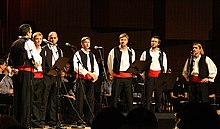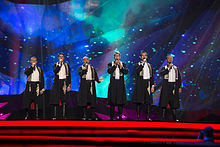| Klapa | |
|---|---|
 Male klapa "Sagena" in the Vatroslav Lisinski Concert Hall Male klapa "Sagena" in the Vatroslav Lisinski Concert Hall | |
| Stylistic origins | Croatian music |
| Cultural origins | Dalmatia |
| Typical instruments | Human voice |
| Klapa multipart singing of Dalmatia, southern Croatia | |
|---|---|
| UNESCO Intangible Cultural Heritage | |
| Country | Croatia |
| Reference | 00746 |
| Region | Europe and North America |
| Inscription history | |
| Inscription | 2012 (7th session) |
| List | Representative |
Klapa music is a form of traditional a cappella singing with origins in Dalmatia, Croatia. The word klapa translates as "a group of friends" and traces its roots to littoral church singing. The motifs in general celebrate love, wine (grapes), country (homeland) and sea. Main elements of the music are harmony and melody, with rhythm very rarely being very important. In 2008, Croatian Ministry of Culture proclaimed it Croatian Intangible Cultural Heritage. In 2012 klapa was inscribed in UNESCO Intangible Cultural Heritage of Humanity.
Description
A klapa group consists of a first tenor, a second tenor, a baritone, and a bass. It is possible to double all the voices apart from the first tenor. It is usually composed of up to a dozen male singers. In recent times, female vocal groups have been quite popular, but in general male and female groups do not mix.
Although klapa is a cappella music, on occasion it is possible to add a gentle guitar and a mandolin (instrument similar in appearance and sound to tamburitzas). Klapa can also be accompanied with synthesizer keyboards, usually simulating percussion instruments.
Modern day

The klapa tradition is still very much alive, with new songs composed and festivals held. The Festival of the Dalmatian Klapas in Omiš is the best known music festival and has a long tradition in Klapa music. Many young people from Dalmatia treasure klapa and sing it regularly when going out eating or drinking. It is not unusual to hear amateur klapa singing on the streets in the evenings over some food and wine.
In 2013, Croatia chose a klapa group to represent the country at the Eurovision Song Contest 2013. The klapa group was called Klapa s Mora, with the entry "Mižerja". Klapa s Mora is a "super klapa ensemble" of six performers chosen by Maestro Mojmir Čačija from five existing klapa groups, namely two from Kampanel, and one each from Sinj, Crikvenica, Šibenik and Grdelin.
There are klapa ensembles in Croatian diaspora as well. Since 2011, Croatian Culture Association in Burgenland organizes Festival klapov ("Klapa festival").
See also
References
- John Everett-Heath. "Dalmatia." Concise Dictionary of World Place-Names. Oxford University Press. 2005. Encyclopedia.com
- Joško Ćaleta (April 1997). "Klapa Singing, a Traditional Folk Phenomenon of Dalmatia". Narodna umjetnost: Croatian Journal of Ethnology and Folklore Research. 34 (1). Zagreb, Croatia: Institute of Ethnology and Folklore Research. ISSN 0547-2504. Retrieved 2013-02-12.
- "Rješenje" (PDF) (in Croatian). Ministry of Culture, Croatia. 14 March 2008. Archived from the original (PDF) on 12 November 2011.
- UNESCO: Klapa multipart singing of Dalmatia, southern Croatia
- ^ Festival of the Dalmatian Klapa in Omis
- "Mižerja to be the Croatian entry in Malmö". eurovision.tv. eurovision.tv. Retrieved 2013-01-16.
- "Festival klapov ov put u Pinkovcu". Hrvatske novine (in Croatian). 25 October 2024.
| UNESCO Intangible Cultural Heritage elements in Croatia | |
|---|---|
| |
| Shared |
|
| Need of Urgent Safeguarding |
|
| Good Safeguarding Practices |
|
